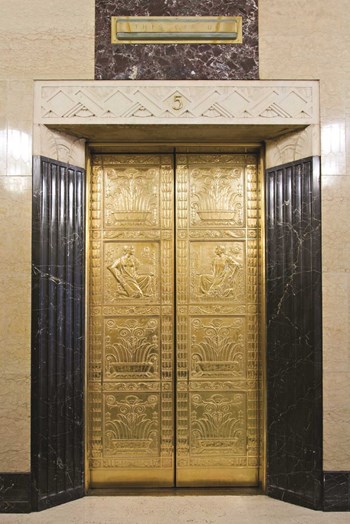
To many people, the elevator isn’t just a device to get you up or down. Wood paneling, exotic woods, carpets, mirrors, chandeliers, brass operating panels—that’s what you’ll see when you go into many elevators in high-end buildings.
Time was, before 1920 or so, when just living in an elevator building was considered a luxury. Many of the elevators of that period reflected that, with chandeliers and velvet couches. Then, elevators became more common and more utilitarian. Now, many designers want to redefine the elevator as a luxury item once more.
The total effect of entering one of today’s luxury elevators—whether made by Schindler, Dayton, Concord or another manufacturer, or just custom designed—is that you’re not just entering an elevator but entering another, luxurious room in the lobby.
“Luxury elevators are really custom-made pieces of furniture. They could have rich traditional wood design, contemporary glass design, woven wire mesh, stainless steel, brass, stone—there’s a whole variety of what can be done,” says Doug Gilman of Elite Elevator Cab Remodeling in Garden City Park. Mirrors, which give a sense of space, are also common, but most experts agree that wood is the most common décor.
Moreover, if you think such elevators can only be found in the equivalent Trump Village, you’re mistaken. “They’re all up and down Fifth and Park Avenue, almost every building. We have them in Brooklyn now, and even in Forest Hills,” Gilman adds.
Even refurbished elevators in less luxurious developments nowadays will incorporate elements of luxury design, whether stainless steel panels, some wood paneling or laminated material with a wood finish. This is certainly an improvement over the plain-looking, painted-metal elevator interiors of yesterday, familiar to those of us who didn’t grow up in luxury buildings.
There’s no sign that the trend toward ornate design is lessening to any great degree. As a matter of fact, in some buildings that are being renovated, once-ornate elevators that were simplified or neglected over the years are being restored to their original opulence. Elaborate design isn’t necessarily a problem, because elevator “cab” design is independent of the internal workings of the elevator per se.
Condos and co-ops who want such a design can bring a cab company in, which in turn can bring samples of wood, veneers and so on, says Kenneth Breglio of BP Elevator in the Bronx. Sometimes the board meets with the elevator consultant or company—and some condos and co-ops will even have special elevator committees to do the job.
Nuts and Bolts
What’s underneath all this fancy material? Here’s a little primer on how elevators work.
There are basically two types of elevators. A hydraulic elevator is one that operates by means of a fluid-driven piston mounted inside a cylinder and connected to a pumping system. Hydraulic elevators give a smooth ride, but often impractical for taller buildings because of space requirements, and are relatively inefficient.
The most popular type of design is the cable or rope system, in which the car is raised or lowered by traction steel ropes—don’t worry, elevators don’t use the type of rope you used to climb in gym class. Some use gears to rotate the sheaves, which are basically large pulleys. In gearless elevators, the motor rotates the sheaves directly.
Whatever type the elevator is, nowadays, computerization with the use of solid-state components has brought big changes in the elevator world.
For example, safety devices (or “safeties”) are just one aspect that has been improved by computerization, according to Mike Duffy, a member of the Local One union of the International Union of Elevator Constructors, who runs his own union-oriented web site.
“Safeties were invented [by elevator pioneer Elisha Otis as early as the 1850s],” he says, “to stop the elevator from crashing into the elevator pit.” However, he says, “The old safeties were mechanical. Today’s safeties incorporate sophisticated software that can monitor everything from how fast the car is traveling in each direction to how many people are in the car.” Many current elevators also have battery backup units that deliver the elevator to the ground floor in the event of a power blackout.
Newer elevators, like newer electronic devices in general, are also much more energy-efficient, reducing power demand.
Another important change, according to Scott Hayes of Hubert H. Hayes, Inc. elevator consultants in Brooklyn, has been the introduction during the past 30 years or so of variable-speed AC (alternating current) controls for elevators, which accelerate and decelerate smoothly. In the past, he says, elevators had single-speed AC controls, which “stopped on the fly.”
Sometimes these older elevators—many of which are still in service, particularly in the outer boroughs—could stop a few inches above, or a few inches below, the door. Fortunately, this vertical “gap” is usually small enough to be more of an annoyance than anything else.
Simpler or More Difficult?
Whether or not all these improvements have made elevator maintenance simpler or more difficult depends on whom you talk to. Many experts say that repairing older elevators is more difficult because there are more moving parts and more relays, or electric switches that open or close under the control of another electrical circuit. “Anything that moves,” says Duffy, “is bound to wear out or break.”
Of course, cost and upkeep have made some older elevators ripe for overhaul or replacement, if not obsolete, as parts for these elevators get more and more expensive and harder to obtain. And, of course, because these older elevators have more moving parts, there are more parts and contacts to be serviced.
But there are two sides to this question. In many cases, computerized compartments—particularly circuit boards that control motors—can cost thousands of dollars. And many parts, Hayes points out, “don’t have the same life expectancy of the older relay parts, which were the same for 30 or 40 years. When you have electronics, in 10 years, the manufacturer may not be supporting it.”
What government entity is responsible for elevator safety and upkeep in this city? In New York City, it’s the city’s Department of Buildings (DOB). As far as codes are concerned, the city has its own elevator code with thousands of parts to it, and the code is updated periodically. As a matter of fact, says Hayes, the city just changed its elevator code to be more in synch with the national and international standards.
Whatever the changes in the code, the city takes violations seriously. Just this past March, the DOB has announced that it would get tough on elevator-code operators. It is now posting the addresses and owners of the 10 buildings with the worst elevator violations on its website: (http://www.nyc .gov/html/dob/html/violations/top10_elev_offenders.shtml.)
The DOB is also seeking legislation that would allow it to impose $1,000 fines for each day an elevator is out of service.
Of course, it would be difficult for building managers, who almost always are not skilled elevator mechanics, repair persons or engineers, to keep on top of all these regulations and changes in the code.
The building managers and superintendents, therefore, usually rely on their elevator companies and elevator consultants, according to Breglio. In addition to handling complaints and necessary modifications, the companies will also hold seminars for managers, says Breglio, who is also president of the Elevator Conference of New York, a trade organization.
‘Elevator Inspected by…’
How often are residential elevators inspected? There are two types of inspections. First, there are those inspections that are done by the DOB itself—or more likely, by contractors engaged by the DOB. Those framed documents you sometimes see inside elevators that say, “inspected by ——-” and the date are the result of such inspections. The second type of inspection can be by the building’s own licensed “agency” or elevator contractor.
“Currently,” says Hayes, “the code requires that elevators be inspected five times in three years by the city and private agencies.” In addition, “Under the current code, elevators are required to have the no-load safety test every two years, and a full-load test [where the elevators are loaded up to their limit] every five years.” Under the new code, he added, this will change.
An inspection, says Duffy of the IUEC, involves a detailed look at the entire elevator—the shaft, the motor room, the cab and the doors on every floor. Breglio adds that, his company, in its multi-maintenance contract, inspects elevators every six months—checking the contacts and relays, making sure everything is working properly, and lubricating the parts. In this city, if there is a problem, the building’s elevator contractor takes care of it—it’s part of his contract. There are some conditions, says Hayes, that get rated “unsatisfactory” but are not necessarily hazardous. One example might be a dirty elevator pit [that portion of the shaft below the lowest point the elevator goes], another might be oil found on the floor in the machine room. No matter what the problem, it must be addressed.
How much does an elevator inspection and/or maintenance checkup cost? A typical range of fees, experts say, can range anywhere from $300 to $2,000 or so. Factors influencing the price can be the number of elevators in a building—obviously, the more elevators in a building, the more pricey the inspection will be. Price is also dependent on the type of elevator as well.
“An elevator inspection of a five-story building with gearless, high-speed elevators is more than a hydraulic elevator in a two-story building,” says Hayes.
It’s the Door
Experts agree that the most common problems with elevators are related to their doors. The door gets more use from passengers than any other part of the elevator, except maybe the buttons. And with people holding the doors open with their arms to let others in or to talk to neighbors, it’s no wonder. Perhaps they should use the “open” button instead.
In order to get the proper training and/or certification, elevator inspectors and repair professionals must work for a licensed inspection agency or contractor that is listed with the city, take certain educational components, and pass a test.
Duffy says that members of his union receive four years of on-the-job and classroom training, culminating in an exam. Breglio’s employees belong to another local, Local Three of the International Brotherhood of Electrical Workers, which also requires a three- to four-year training program.
Raanan Geberer is a freelance writer and editor living in New York City.






8 Comments
Leave a Comment